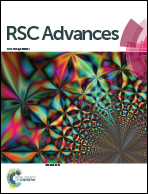Adhesion and bending rigidity-mediated wrapping of carbon nanotubes by a substrate-supported cell membrane†
Abstract
A fundamental understanding of the adhesive interaction between carbon nanotubes (CNTs) and a cell membrane is essential for the design and potential applications of CNT-based drug delivery systems, gene carries, as well as biosensors. In this work, we set up a theoretical model to explore the wrapping effect of a substrate-supported membrane on CNTs, taking the deformation of CNTs into consideration. Our results show that the competition between the membrane bending stiffness and the CNT–membrane adhesion strength induces a double-edged effect on the stability of a single CNT wrapped by a substrate-supported membrane, that is, the membrane can facilitate the laying down and collapse of the CNT due to its bending rigidity, while it tends to maintain the upright and open shape of the CNT as a result of the CNT–membrane adhesion. The phase boundary for the open and collapsed configurations due to this competition can be well described by a simple analytical model. Furthermore, the competition can also result in the transition of the membrane between adhering to and detaching from the substrate in the system of two widely spaced CNTs covered by a substrate-supported cell membrane, which is consistent with experimental observations.


 Please wait while we load your content...
Please wait while we load your content...